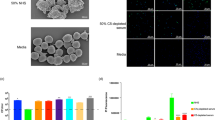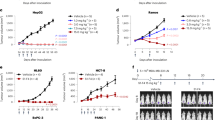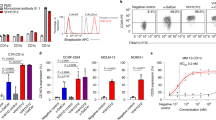Abstract
Antibody molecules are bivalent, or less often multivalent, with each antibody site within a single molecule having the same specificity. Bivalency must enhance the tenacity of antibody attachment to cell surfaces, as dissociation will require simultaneous release at both sites. However, the bivalency of the antibody sometimes induces a target cell to undergo antigenic modulation1–3, thereby offering the cell a means of evading complement and the various effector cells recruited by the antibody. We have investigated the attack by univalent antibodies, which, despite removal of one antibody site, retain their Fc zones and hence their ability to recruit the killing agents, on neoplastic B lymphocytes of the guinea pig L2C line. Rabbit antibodies raised against surface immunoglobulin of these cells were partially digested with papain to yield the univalent Fab/c derivatives4,5. We report here that these derivatives showed enhanced cell killing both in vitro and in vivo, and that this enhancement appeared to derive from avoiding antigenic modulation.
This is a preview of subscription content, access via your institution
Access options
Subscribe to this journal
Receive 51 print issues and online access
$199.00 per year
only $3.90 per issue
Buy this article
- Purchase on Springer Link
- Instant access to full article PDF
Prices may be subject to local taxes which are calculated during checkout
Similar content being viewed by others
References
Boyse, E. A. & Old, L. J. A. Rev. Genet. 3, 269–290 (1969).
Stackpole, C. W., Jacobson, J. B. & Lardis, M. P. J. exp. Med. 140, 939–953 (1974).
Gordon, J. & Stevenson, G. T. Immunology 42, 13–17 (1981).
Goodman, J. W. Biochemistry 4, 2350–2357 (1965).
Michaelsen, T. E. & Natvig, J. B. Scand. J. Immun. 1255–1268 (1972).
Stevenson, G. T., Eady, R. P., Hough, D. W., Jurd, R. D. & Stevenson, F. K. Immunology 28, 807–820 (1975).
Hough, D. W., Chapple, J. C., Stevenson, F. K. & Stevenson, G. T. Immunology 34, 889–899 (1978).
Stevenson, F. K., Elliott, E. V. & Stevenson, G. T. Immunology 32, 549–557 (1977).
Stevenson, G. T., Elliott, E. V. & Stevenson, F. K. Fedn Proc. 36, 2268–2271 (1977).
Press, E. M. Biochem. J. 149, 285–288 (1975).
Isenman, D. E., Dorrington, K. J. & Painter, R. H. J. Immun. 114, 1726–1729 (1975).
Lamm, M. E., Boyse, E. A., Old, L. J., Lisowska-Bernstein, B. & Stockert, E. J. Immun. 101, 99–103 (1968).
Taylor, R. B., Duffus, P. H., Raff, M. C. & de Petria, S. Nature new Biol. 233, 225–227 (1971).
Metzger, H. Contemp. Topics molec. Immun. 8, 119–152 (1978).
Sissons, J. G. P. et al. J. exp. Med. 150, 445–454 (1979).
Hamblin, T. J., Abdul-Ahad, A. K., Gordon, J., Stevenson, F. K. & Stevenson, G. T. Br. J. Cancer 42, 495–502 (1980).
Prahl, J. W., Mandy, W. J. & Todd, C. W. Biochemistry 8, 4935–4940 (1970).
Fanger, M. W. & Smyth, D. G. Biochem. J. 127, 767–774 (1972).
Gordon, J., Robinson, D. S. F. & Stevenson, G. T. Immunology 42, 7–12 (1981).
Peto, R. Br. J. Cancer 29, 101–105 (1974).
Author information
Authors and Affiliations
Rights and permissions
About this article
Cite this article
Glennie, M., Stevenson, G. Univalent antibodies kill tumour cells in vitro and in vivo. Nature 295, 712–714 (1982). https://doi.org/10.1038/295712a0
Received:
Accepted:
Issue Date:
DOI: https://doi.org/10.1038/295712a0
This article is cited by
-
HIF activation enhances FcγRIIb expression on mononuclear phagocytes impeding tumor targeting antibody immunotherapy
Journal of Experimental & Clinical Cancer Research (2022)
-
Monoclonal antibodies: Implications for virology
Archives of Virology (1986)
Comments
By submitting a comment you agree to abide by our Terms and Community Guidelines. If you find something abusive or that does not comply with our terms or guidelines please flag it as inappropriate.



